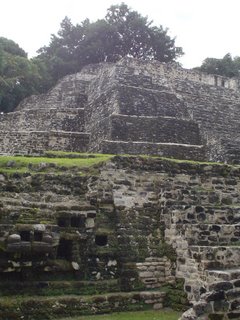Vince, myself and my father took a trip to Belize. We had been wanting to go there for several years but kept putting it off. In my father's youth, he travelled extensively in Central America. Now in his older years, he would like to go to some of the countries that he missed. We were happy to oblige. We've travelled to Europe, Scandanavia, Canada, Mexico & across the US. Plus Vince has travelled alone to Nepal, Australia and India. Now we would like to focus on travels far south of our border.
Finally we decided to stop talking and start travelling! We set out in January 2006. I am an avid birder, which was the main reason I wanted to go to Belize. Vince and my father were more interested in the archaeology. Of course we were all interested in that, as well as the culture and natural beauty of Belize.
I located a lodge in a small fishing village called Crooked Tree. It caters mostly to birders and ecotourists. Crooked Tree (CT) is 33 miles north of Belize City but it is a world away! The village sits on a lagoon that is the prime place for water and shore birds, as well as neotropical migrants and resident passerines. CT didn't even have road access to Belize City until 1984 when the causeway was built. Before that time, people made the trip by boat.
CT is a completely walkable village. People do have cars but there are not too many. People mostly walk, ride a horse, or take a boat. There is only 1 policeman and I think he must mostly be bored...which is a good thing! I doubt there is much crime there because the people living in the village all know each other, are family, and/or are friends.
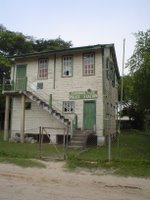
We stayed at the Bird's Eye View Lodge, tucked away on the edge of the village on the shores of the lagoon. Verna & her brother Lenny were excellent hosts. Every evening we had delicious home-cooked meals prepared by Stephanie and her staff. (We could have eaten every meal there but we aren't used to eating 3 meals a day!). Verna kept us entertained with colorful and funny stories. Lenny impressed us with his knowledge of the local flora and fauna - especially the birds. (The birding in Belize is amazing...such diversity...and they're everywhere!) Everyone at the lodge and in the village were beyond friendly. It was like we had known each other for years.
Verna & her brother Lenny were excellent hosts. Every evening we had delicious home-cooked meals prepared by Stephanie and her staff. (We could have eaten every meal there but we aren't used to eating 3 meals a day!). Verna kept us entertained with colorful and funny stories. Lenny impressed us with his knowledge of the local flora and fauna - especially the birds. (The birding in Belize is amazing...such diversity...and they're everywhere!) Everyone at the lodge and in the village were beyond friendly. It was like we had known each other for years.
We took a 30 mile boat ride up the New River to Lamanai, one of the longest occupied Mayan sites - 3,000 years. The boat zigzagged and wove along the river.  It was beautiful scenery through jungle habitat.
It was beautiful scenery through jungle habitat.
We passed Cohune palm forests and marsh areas. Along the way, we stopped to look at crocodiles and turtles sunning themselves upon the logs. The boat dodged in and out of rain showers but we dried quickly.

Our arrival at Lamanai lagoon was dramatic because of the view of the Mayan ruins pushing up through the tall tropical broadleaf forest trees (aka jungle). From out in the lagoon, we could see a jabiru stork nest. It was the size of a Volkswagon! These birds are the largest flying bird in the Americas. They stand 5 feet tall and have wingspans of 10 to 12 feet! Lamanai means "submerged crocodile" in Mayan. The site was occupied as early as 1500 BC. Mayans lived here until the arrival of the Spainards in the 16th century.
We walked around Lamanai, saw howler monkeys - but I couldn't get a good picture...bummer. When we reached the Lag Temple, we were crazy enough to climb it. It wasn't so bad climbing up the steep temple and the views were spectacular across the jungle. However, after seeing the views that the Mayan people saw, the climb down became a reality!

It was a nerve-racking experience. We needed total concentration. I tried not to look down past my feet or to look around to the sides.

One slip could have sent us tumbling to the earth like a sacrafice gone awry! And if we were alive after the fall, we probably would die before we were rescued & taken to Belize City.
When our feet touched the earth again and we gazed nearly vertically up at where we just descended from, we were grateful for the experience and grateful to be down safely.
On the boat ride back, we passed by the Mennonite farming community of Shipyard. The Mennonites provide most of the dairy and chicken for all of Belize. We also passed traditional fishermen in dugout canoes which were gently gliding along the water surface - until we came along.
When we reached Orange Walk, Lenny picked us up and took us on a short tour through the town and to look at the sugar cane factory - which is the only one now open in the entire country - hence the long lines of trucks waiting to drop off their cane. The country is divided into 4 districts and each is assigned a specific time to deliver/drop off the sugar cane. Trucks would wait in line up to a week to unload! Drivers either sleep in their trucks or leave the trucks parked in line and get a ride back to their home; then come back in a week.

Back in CT, Vince and I did a lot of birding and even visited with the village crocodile - who's been accused of eating the village chickens! One day we hired a local man and his horses and took a 3 mile horseback ride through the outskirts of CT. Although there was hardly an elevational climb, there was a noticeable change in habitat from the jungle forest & lagoon to the pine forests. The difference of plant communities is due to the soil type.
The horseback riding was enjoyable (although I'm not much of a horse person). I was trying to bird from horseback and it wasn't going too well. As soon as I would see a bird and pull my binoculars up, the bird would be gone and I'd be bouncing on down the gravel road. Oh well. By the end of the ride, my "bum" was very sore and I could hardly walk. I had to use the rest of the afternoon to relax, visit with Vince and my father, look at birds - from a stationary position! - and finally try bird watching from a canoe. (I never give up!)
Oh well. By the end of the ride, my "bum" was very sore and I could hardly walk. I had to use the rest of the afternoon to relax, visit with Vince and my father, look at birds - from a stationary position! - and finally try bird watching from a canoe. (I never give up!) 
Yet again, not a good idea if you actually want to identify the birds instead of a blob. But we did have one really cool close encounter. We came within 5 feet of a Common Black Hawk perched atop a mangrove. We were able to sneak up on it with the canoe. The canoe route we took was actually a 2-track road during the dry season, but during the wet season it floods and becomes a boat lane.
We left Crooked Tree and took a ferry to Caye Caulker - a sleepy island village that sees far fewer tourists than it's twin Ambergis Caye. On the ferry ride there, it began to rain. Our rain gear was packed away and not accessible. The ferry attendant handed out a tarp for each side of the boat. We each had to hold it above our heads (just like the parachute game we played in elementary school)!
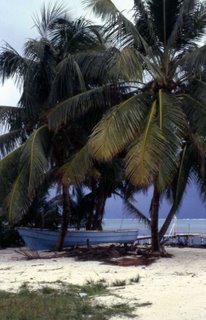
When we arrived at Caye Caulker, we had no idea of where to stay. We started walking along the main street. The island is only about 4 miles long and the main area for accomodations is only about 1 mile long, so we weren't too worried about walking. We just knew that if we walked toward the end of the island, we'd find more secluded accomodations. We took a beach trail through an old cemetery (where we saw an iguana sunning itself every day upon a tombstone) and followed it to the hotel we eventually selected.

The birding was not too exciting on Caye Caulker but I did see Brown Pelicans, which I always find to be a treat.

Again, on Caye Caulker, we took things slow and relaxed. Nobody moves fast on this island anyways...why would they? There are just a few cars. There is no need to have a car. I can't figure out why anyone would want one. People either walk or ride a bike. A few people drive around on golf carts but not many (on Ambergis Caye - San Pedro, too many people use golf carts and it's a mess and quite annoying. Sadly, it's hard to be a pedestrian there). On Caye Caulker, they do use a mini-fire engine and it seems like it works well for the structures there. I was so taken with the mini-fire engine that I basically chased it around for days until I had a good photo opportunity.

On the islands, they transport and deliver bottled water, cokes, etc. using a tractor. 
And trash collection is done by entrepreneurs who ride bikes around (note the individual plastic grocery bags filled up with trash).
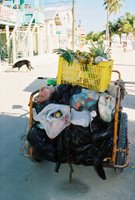 Every house has a rain water catchment system. Although they get quite a bit of rain (as compared to where we live), I'm sure they ration their water.
Every house has a rain water catchment system. Although they get quite a bit of rain (as compared to where we live), I'm sure they ration their water.
School-aged kids went to the Catholic school. Everyday after school, the back streets would be busy with uniformed kids walking home. No need for buses or parental escorts on Caye Caulker. All seems safe. The police (only saw 2 of them) rode bicycles and weren't carrying firearms.
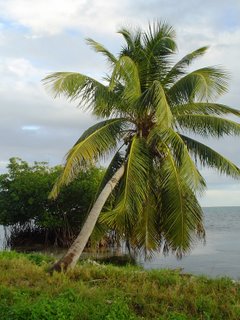 We spent our time on the island just strolling around and taking things slow. Every angle is a photo op on CC. The blue water, the island vegetation, the buildings, the friendly people...
We spent our time on the island just strolling around and taking things slow. Every angle is a photo op on CC. The blue water, the island vegetation, the buildings, the friendly people...
Continue on to "Belize 2006 - part 2."
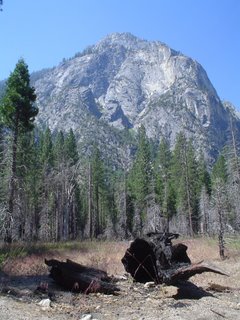

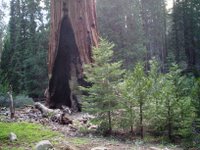


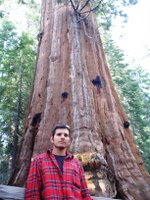





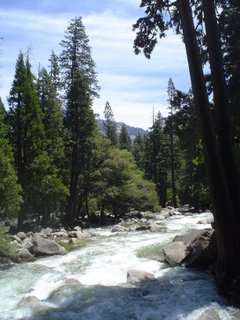



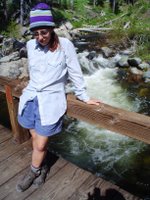



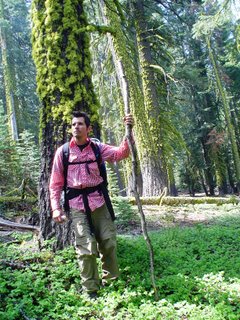



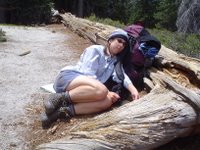

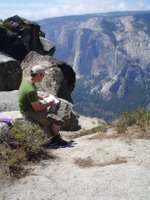


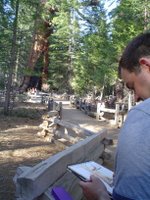
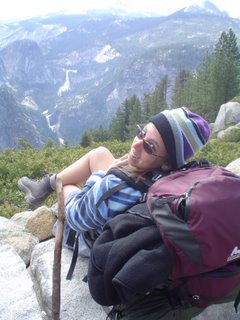

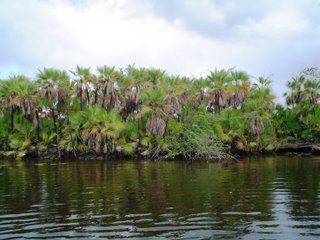





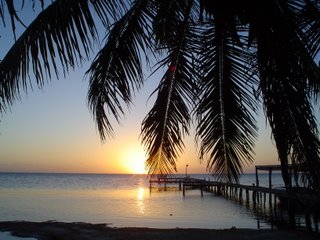
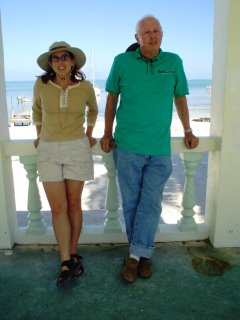
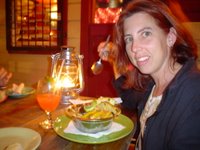

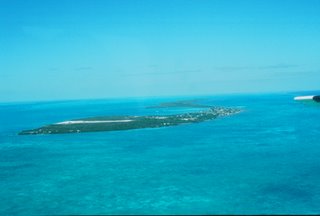


 Verna & her brother Lenny were excellent hosts. Every evening we had delicious home-cooked meals prepared by Stephanie and her staff. (We could have eaten every meal there but we aren't used to eating 3 meals a day!). Verna kept us entertained with colorful and funny stories. Lenny impressed us with his knowledge of the local flora and fauna - especially the birds. (The birding in Belize is amazing...such diversity...and they're everywhere!) Everyone at the lodge and in the village were beyond friendly. It was like we had known each other for years.
Verna & her brother Lenny were excellent hosts. Every evening we had delicious home-cooked meals prepared by Stephanie and her staff. (We could have eaten every meal there but we aren't used to eating 3 meals a day!). Verna kept us entertained with colorful and funny stories. Lenny impressed us with his knowledge of the local flora and fauna - especially the birds. (The birding in Belize is amazing...such diversity...and they're everywhere!) Everyone at the lodge and in the village were beyond friendly. It was like we had known each other for years.

